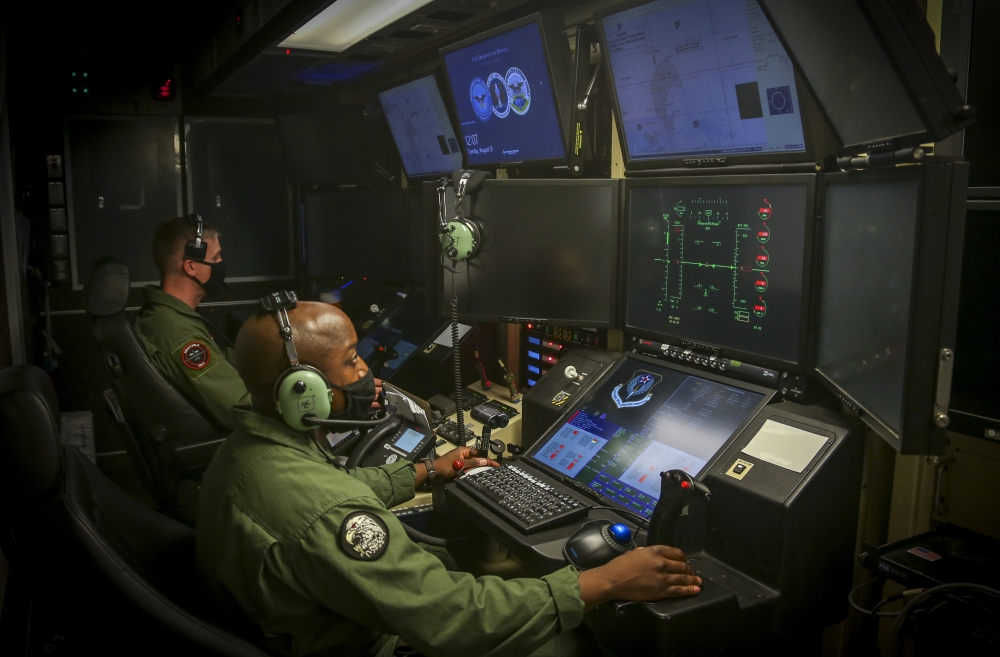
U.S. Marine Corps Captain Joshua Brooks, an unmanned aircraft system representative, and Master Sergeant Willie Cheeseboro Jr., an enlisted aircrew coordinator with Marine Unmanned Aerial Vehicle Squadron 1, prepare to launch and operate the first Marine Corps owned MQ-9A Reaper on Marine Corps Air Station Yuma, Ariz. Aug. 30, 2021
The US Marine Unmanned Aerial Vehicle Squadron 1, 3rd Marine Aircraft Wing, procured the Marine Corps’ first MQ-9A “Reaper” remotely piloted aircraft after transitioning from contractor owned, contractor operated to government owned, contractor operated at Marine Corps Aircraft Station Yuma, Arizona, August 30, 2021.
In order to achieve the Commandant of the Marine Corps’ vision of future force design, VMU-1 has transitioned from the RQ-21 Group 3 unmanned aircraft to the MQ-9A. Since 2018, flight operations of the MQ-9A have fallen under a COCO construct. However, the MQ-9A has since transitioned to a GOCO unmanned aerial system, signifying the Marine Corps ownership of these assets and progressing toward an organically trained and qualified aircrew.
This noteworthy flight is the culmination of three years of training, safety and operational planning, contractor maintenance, process development and staff analysis of risk management to ensure complete procedural adherence to Navy and Marine Corps aviation policies.
“VMU-1 is living the Commandant’s vision of Force Design 2030, and our unit is laying the groundwork for future squadrons to execute similar missions within INDOPACOM [U.S. Indo-Pacific Command] or anywhere else that we are needed,” said Maj. Keenan Chirhart, executive officer of VMU-1.
VMU-1’s procurement of the Marine Corps’ first MQ-9A evolves the service as a force, making it capable of further integration of operations in naval, ground, air, and cyber domains. As the Marine Corps transitions to government owned, government operated employment of the MQ-9A, Force Design 2030 presents opportunities for similar implementation across the globe. This transition gives VMU-1 the capability of piloting the forward deployed MQ-9A that aligns with the Commandant’s directive for persistent intelligence, surveillance and reconnaissance capabilities, which have supported daily combat operations around the world.
“The MQ-9A is a medium altitude, long endurance Group 5 remotely piloted aircraft capable of conducting multiple mission sets to include multi-sensor imagery reconnaissance, unmanned aerial escort, and electronic support,” said Chirhart.
Aside from being the first Marine Corps owned MQ-9A flight in history, this flight is also a huge step toward verification of policies and procedures that have been developed by VMU-1. With this transition to the MQ-9A, VMU-1 is currently engaged in executing maritime domain awareness operations in highly contested areas, providing friendly forces a multi-domain reconnaissance capability across the electromagnetic spectrum. Moreover, it proves that VMU-1 is uniquely positioned to enable naval and joint force targeting from a remote location by a Marine aviator and sensor operator, while the aircraft is physically located within another combatant commander’s area of operation.
The MQ-9A was developed by General Atomics Aeronautical Systems Incorporated. The remotely piloted aircraft capability revolutionizes military operations by allowing the system operator to operate from ship and shore, and employ both collection and lethal payloads while integrating with command and control centers, allowing the synchronization of remotely piloted aircraft with ground and air assets.
3rd MAW continues to “Fix, Fly and Fight” as the Marine Corps’ largest aircraft wing, and remains combat-ready, deployable on short notice, and lethal when called into action.
Photo: U.S. Marine Corps photo by Lance Cpl. Gabrielle Sanders
Source: Marines

How very sad that the Taliban, and its Chinese supporters, received one first.